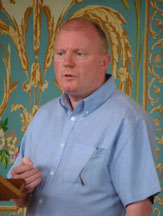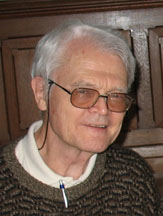|
no. 3 july - september 2006
Two Volume Publication Makes Lived Charism Available in German Ms. Helga-Maria Jaeger, a member of the Third Order community in Straubing, Germany published a two volume book on the lives of the Carmelite saints and blesseds in the German language. Although she was professed into the Carmelite Third Order on November 14, 1999, her interest in Carmel began when she was 14 years old and received a copy of a book on Elizabeth of the Trinity from her piano teacher. The life and spirituality of this 20th century German woman fascinated the young Helga. The spirituality spoke to her. The town of Deggendorf where she spent most of her childhood had no Carmelite monastery but this did not stop her from reading whatever she could find on the Order. Her second meeting with the Carmelites came during her studies in Regensburg. She frequented both the Marienschwestern church and the Discalced Carmelite church. There she discovered the autobiography of Therese of Lisieux. Her work took her to the beautiful Bavarian town of Straubing and he became acquainted with the Carmelites there where eight years ago she joined the Lay Carmelites. She calls it her third stop on her journey in Carmel. What moved you to decide to become a member of the Third Order? It was a decision that developed inside of me from my early youth to belong to this Order. It was a call that I heard over and over. I agree with what the Prior General wrote in his letter on the anniversary of the papal bull Cum Nulla: "Being a Lay Carmelite is not just a devotion added to life; it is a way of life; it is a vocation." It was not possible for me to enter an enclosed Carmelite monastery so I am able to commit myself to the Order and to live its charism as a lay woman. How did the idea of publishing a book on the holy men and women of Carmel come about? Fr. Elias Steffen, the Carmelite chaplain of the Third Order Carmelites in Straubing encouraged me and I was excited about the possibility. He believed that there needed to be a collection of all the saints and blesseds of the Carmelite Order in the German language. He felt if should include the affiliated Congregations and Institutes as well. As I did Carmelite formation, I was also very concerned that there was little Carmelite literature in German. So I thought this would be a good project to take on in my early retirement. I think Carmel has so many interesting personalities to hold up to the world that is well worth the time and energy to work to make these rich treasures available to others. The Prior General told about us inheriting a great tradition and the sacred responsibility we have to pass that tradition on to others. This too is part of our vocation. How did you go about compiling the information for the book? I have a Carmelite library in my home, books that I have acquired over the last four decades. I found other books at bookstores and in churches. I also discovered important sources in the very rich library in the Carmelite monastery in Straubing. It was there that I came across the two books in English [ed note: Profiles in Holiness, vol 1, 2] by Redemptus Maria Valabek, a former Postulator General, which contained Carmelites involved in the canonization process. I put these in the second volume of my work. I attempted to keep the book as current as possible, right up to before the beatification of Madre Crocifissa Curcio. The format of including a short biography, then meditation, then questions and prayer for each person in the book differs from more traditional books on the saints. What did you decide to do it that way? This goes back to a suggestion from Fr. Elias and I think it made a lot of sense to do it that way. I am attempting to clarify the holy person’s life by these other means in addition to the traditional biography. They are also intended to be a means of connecting more with the life of the reader. They are also useful for groups or as an activity for a religious community. I wrote the prayers at the end of each chapter as an attempt to capture the charism of each holy one. By including lectio divina, I wanted to emphasize this traditional form of prayer on the Word of God. For me, these men and women lived the Carmelite life. I may or may not admire the individual being written about but I must ask myself: What of their life can I bring into my own life, within my particular circumstances? How do I life my life under the influence of Carmelite spirituality? That is the value of studying these lives. You include both Carmelites and Discalced Carmelites in the book. You mentioned attending Mass at the Discalced Church in Regensburg. How much of an influence has the idea of a "Carmelite Family" had on you as a Lay Carmelite? Carmel is a tree with two main trunks, the Carmelite Order and the Discalced Carmelite Order, and many branches (the affiliated Congregations and Institutes). We all belong and we live the Carmelite vocation in our own way—allowing for the creativity of the Holy Spirit. That is the fascinating part for me and I hope I showed it in my book. Perhaps we don’t stress enough that we are part of a world-wide family. It would be very enriching if we did so. In compiling this book, I had good contact with different monasteries. Their support and their interest showed me that the Carmelite Family is alive and well. It would be good to build on this, especially for communication between the various groups of Lay Carmelites. How has the book been received? Overall the reaction has been very positive. It was stressed over and over again that it is important to make more Carmelite literature available in German. The various parts of the various chapters were seen as helpful and positive. I also received comments from clergy around the world and from members of other Lay Carmelite communities. They thought the book would be useful for days of recollection as well as parish activities. Certainly the book is not well-known outside of the Order but I do not think it is very well known within the Order either, certainly not with the members of Third Order or the Confraternities. That will probably take a couple of years. Do you have any more projects in mind? No projects for the foreseeable future. This book cost me a lot in terms of energy. It takes a while to settle back down internally but if this book helps people in their spiritual journey then all the trouble was worthwhile.
The 3rd National Gathering of Lay Carmelites of the British Province took place at Aylesford, UK, 21-23 April, 2006. On the opening night, John Berry was formally commissioned as lay Provincial Delegate by Prior Provincial Tony Lester O. Carm. Following on from the 1st National Gathering in December 2002, Stoking the Flame, and in 2004, Keeping the Flame Alive, the theme for this 3rd National Gathering was Passing on the Flame. This was appropriately enacted on the Saturday evening when each delegate took a candle bearing his/her own name and lit it from the Paschal Candle before entering into Lectio Divina and a period of silence. Delegates processed to the shrine of Our Lady of the Assumption and placed their candles on the altar of Carmelite Saints where the candles remained until after Mass the following day. During the following two days sessions included the keynote address, Spiritual Leadership, given by Prior Provincial Tony Lester. Some of the questions addressed were Who is Carmel for? and What does Carmel need to be or do to be authentically Carmelite? Is the Third Order of Carmelites just something we do on a Wednesday night? – Or is it a vocation, our way of life? There was an introduction to the new Guidelines for Elections and a group was formed to commence work on writing local statutes for the British Province. Discussions on financial and administrative matters were included, with the flame forming a unifying focus at the sessions and liturgies. Carmelite hospitality was at its best and a particular welcome was given to guests Anita Renehan from Rome, International Secretary for Lay Carmelites and to Mary Farrell, National Councillor of the Discalced Secular Order. The gathering closed with delegates collecting the new Lay Carmelite information brochures for distribution within their communities to assist the members in "Passing on the Flame".
In June this year Australian Carmelites were treated to a visit by Fr Carlos Mesters, O.Carm. A simple, softly spoken, gentle man with a wonderful twinkle in his eyes, Carlos enlightened his audiences wherever he spoke. Lay Carmelites were fortunate to meet him either in Melbourne or Sydney where he conducted a one- and two-day retreat, respectively. During this special time of enrichment Fr. Carlos constantly encouraged us to open our eyes to God; to recognise His presence and action in our daily lives through the daily practice of Lectio Divina. With great scholarship and much humour, Carlos revealed the true message behind some of the biblical stories, and in so doing reinforced our faith in Jesus and love of his Word. We were very grateful for being led, like the disciples on the Road to Emmaus, to many enriching insights: "Did not our hearts burn within us?" Formation and Communication at the Service of the Community: Primary Ingredients for an Effective Carmelite Website Scientific studies (and our own statistics) indicate that more and more people are receiving their information, especially religious information, via the Internet. The presence of our various Lay Communities on the Internet with well-developed, attractive homepages could be one of the most effective means of evangelization in today’s world. It costs very little and there are always people willing to help get an initial page setup on the Internet.
Lay Carmelite International Congress Twenty-two countries will be represented at the Lay Carmelite International Congress at Istituto "Il Carmelo" Sassone 2-9 September 2006. The theme for the congress is "Formation and Communication at the Service of Community." Talks will be presented by former Prior General John Malley, O. Carm., Miguel Norbert Ubarri, TOC., Sylvia Lucas, TOC., Giambattista Genovese, TOC., Anita Renehan, TOC., and Tito Figuireõa, O. Carm. Eight Lay Carmelites from different countries and cultures will speak briefly about their own personal experience of formation as a Lay Carmelite. The website for the International Congress can be accessed from: carmelites.info/laycarmelites XIXth Congress of the Lay Carmelites of Levante The XIXth Congress of the Lay Carmelites of Levante took place in Onda (Castellón), Spain on June 2-4, 2006. The whole event was very interesting. The main speakers were David Oliver, the Prior Provincial of the Argovalentine Province, who spoke on "Carmel Today: The Missionary Dimension" and Ramón Maneu, the Provincial Delegate for Lay Carmel who spoke on "The Prophetic Dimension of the Order: Justice and Peace."
|
||
|
RETURN TO THE INDEX FOR 2006 | RETURN TO THE INDEX FOR THIS ISSUE INDEX OF CARMELITE
WEBSITES |


